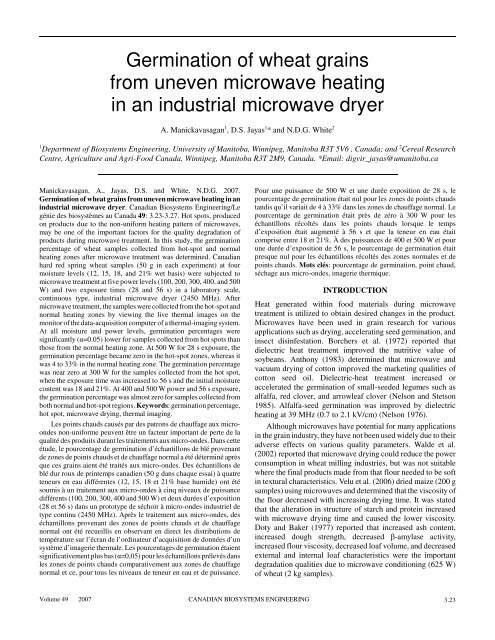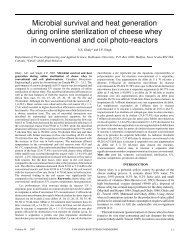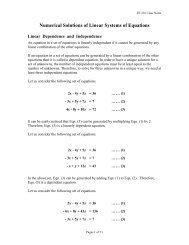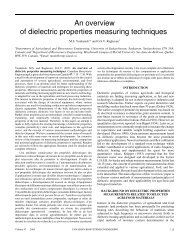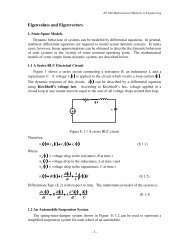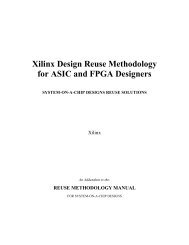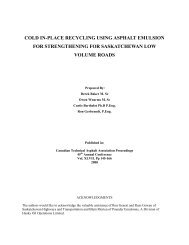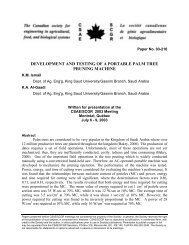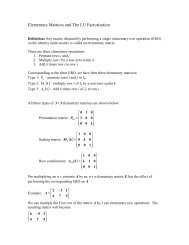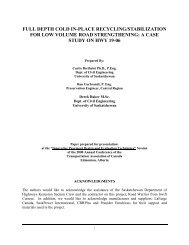Germination of wheat grains from uneven microwave heating in an ...
Germination of wheat grains from uneven microwave heating in an ...
Germination of wheat grains from uneven microwave heating in an ...
You also want an ePaper? Increase the reach of your titles
YUMPU automatically turns print PDFs into web optimized ePapers that Google loves.
<strong>Germ<strong>in</strong>ation</strong> <strong>of</strong> <strong>wheat</strong> <strong>gra<strong>in</strong>s</strong><br />
<strong>from</strong> <strong>uneven</strong> <strong>microwave</strong> <strong>heat<strong>in</strong>g</strong><br />
<strong>in</strong> <strong>an</strong> <strong>in</strong>dustrial <strong>microwave</strong> dryer<br />
A. M<strong>an</strong>ickavasag<strong>an</strong> 1 , D.S. Jayas 1 * <strong>an</strong>d N.D.G. White 2<br />
1 Department <strong>of</strong> Biosystems Eng<strong>in</strong>eer<strong>in</strong>g, University <strong>of</strong> M<strong>an</strong>itoba, W<strong>in</strong>nipeg, M<strong>an</strong>itoba R3T 5V6 , C<strong>an</strong>ada; <strong>an</strong>d 2 Cereal Research<br />
Centre, Agriculture <strong>an</strong>d Agri-Food C<strong>an</strong>ada, W<strong>in</strong>nipeg, M<strong>an</strong>itoba R3T 2M9, C<strong>an</strong>ada. *Email: digvir_jayas@um<strong>an</strong>itoba.ca<br />
M<strong>an</strong>ickavasag<strong>an</strong>, A., Jayas, D.S. <strong>an</strong>d White, N.D.G. 2007.<br />
<strong>Germ<strong>in</strong>ation</strong> <strong>of</strong> <strong>wheat</strong> <strong>gra<strong>in</strong>s</strong> <strong>from</strong> <strong>uneven</strong> <strong>microwave</strong> <strong>heat<strong>in</strong>g</strong> <strong>in</strong> <strong>an</strong><br />
<strong>in</strong>dustrial <strong>microwave</strong> dryer. C<strong>an</strong>adi<strong>an</strong> Biosystems Eng<strong>in</strong>eer<strong>in</strong>g/Le<br />
génie des biosystèmes au C<strong>an</strong>ada 49: 3.23-3.27. Hot spots, produced<br />
on products due to the non-uniform <strong>heat<strong>in</strong>g</strong> pattern <strong>of</strong> <strong>microwave</strong>s,<br />
may be one <strong>of</strong> the import<strong>an</strong>t factors for the quality degradation <strong>of</strong><br />
products dur<strong>in</strong>g <strong>microwave</strong> treatment. In this study, the germ<strong>in</strong>ation<br />
percentage <strong>of</strong> <strong>wheat</strong> samples collected <strong>from</strong> hot-spot <strong>an</strong>d normal<br />
<strong>heat<strong>in</strong>g</strong> zones after <strong>microwave</strong> treatment was determ<strong>in</strong>ed. C<strong>an</strong>adi<strong>an</strong><br />
hard red spr<strong>in</strong>g <strong>wheat</strong> samples (50 g <strong>in</strong> each experiment) at four<br />
moisture levels (12, 15, 18, <strong>an</strong>d 21% wet basis) were subjected to<br />
<strong>microwave</strong> treatment at five power levels (100, 200, 300, 400, <strong>an</strong>d 500<br />
W) <strong>an</strong>d two exposure times (28 <strong>an</strong>d 56 s) <strong>in</strong> a laboratory scale,<br />
cont<strong>in</strong>uous type, <strong>in</strong>dustrial <strong>microwave</strong> dryer (2450 MHz). After<br />
<strong>microwave</strong> treatment, the samples were collected <strong>from</strong> the hot-spot <strong>an</strong>d<br />
normal <strong>heat<strong>in</strong>g</strong> zones by view<strong>in</strong>g the live thermal images on the<br />
monitor <strong>of</strong> the data-acquisition computer <strong>of</strong> a thermal-imag<strong>in</strong>g system.<br />
At all moisture <strong>an</strong>d power levels, germ<strong>in</strong>ation percentages were<br />
signific<strong>an</strong>tly (α=0.05) lower for samples collected <strong>from</strong> hot spots th<strong>an</strong><br />
those <strong>from</strong> the normal <strong>heat<strong>in</strong>g</strong> zone. At 500 W for 28 s exposure, the<br />
germ<strong>in</strong>ation percentage became zero <strong>in</strong> the hot-spot zones, whereas it<br />
was 4 to 33% <strong>in</strong> the normal <strong>heat<strong>in</strong>g</strong> zone. The germ<strong>in</strong>ation percentage<br />
was near zero at 300 W for the samples collected <strong>from</strong> the hot spot,<br />
when the exposure time was <strong>in</strong>creased to 56 s <strong>an</strong>d the <strong>in</strong>itial moisture<br />
content was 18 <strong>an</strong>d 21%. At 400 <strong>an</strong>d 500 W power <strong>an</strong>d 56 s exposure,<br />
the germ<strong>in</strong>ation percentage was almost zero for samples collected <strong>from</strong><br />
both normal <strong>an</strong>d hot-spot regions. Keywords: germ<strong>in</strong>ation percentage,<br />
hot spot, <strong>microwave</strong> dry<strong>in</strong>g, thermal imag<strong>in</strong>g.<br />
Les po<strong>in</strong>ts chauds causés par des patrons de chauffage aux microondes<br />
non-uniforme peuvent être un facteur import<strong>an</strong>t de perte de la<br />
qualité des produits dur<strong>an</strong>t les traitements aux micro-ondes. D<strong>an</strong>s cette<br />
étude, le pourcentage de germ<strong>in</strong>ation d’éch<strong>an</strong>tillons de blé proven<strong>an</strong>t<br />
de zones de po<strong>in</strong>ts chauds et de chauffage normal a été déterm<strong>in</strong>é après<br />
que ces <strong>gra<strong>in</strong>s</strong> aient été traités aux micro-ondes. Des éch<strong>an</strong>tillons de<br />
blé dur roux de pr<strong>in</strong>temps c<strong>an</strong>adien (50 g d<strong>an</strong>s chaque essai) à quatre<br />
teneurs en eau différentes (12, 15, 18 et 21% base humide) ont été<br />
soumis à un traitement aux micro-ondes à c<strong>in</strong>q niveaux de puiss<strong>an</strong>ce<br />
différents (100, 200, 300, 400 <strong>an</strong>d 500 W) et deux durées d’exposition<br />
(28 et 56 s) d<strong>an</strong>s un prototype de séchoir à micro-ondes <strong>in</strong>dustriel de<br />
type cont<strong>in</strong>u (2450 MHz). Après le traitement aux micro-ondes, des<br />
éch<strong>an</strong>tillons proven<strong>an</strong>t des zones de po<strong>in</strong>ts chauds et de chauffage<br />
normal ont été recueillis en observ<strong>an</strong>t en direct les distributions de<br />
température sur l’écr<strong>an</strong> de l’ord<strong>in</strong>ateur d’acquisition de données d’un<br />
système d’imagerie thermale. Les pourcentages de germ<strong>in</strong>ation étaient<br />
significativement plus bas (α=0,05) pour les éch<strong>an</strong>tillons prélevés d<strong>an</strong>s<br />
les zones de po<strong>in</strong>ts chauds comparativement aux zones de chauffage<br />
normal et ce, pour tous les niveaux de teneur en eau et de puiss<strong>an</strong>ce.<br />
Pour une puiss<strong>an</strong>ce de 500 W et une durée exposition de 28 s, le<br />
pourcentage de germ<strong>in</strong>ation était nul pour les zones de po<strong>in</strong>ts chauds<br />
t<strong>an</strong>dis qu’il variait de 4 à 33% d<strong>an</strong>s les zones de chauffage normal. Le<br />
pourcentage de germ<strong>in</strong>ation était près de zéro à 300 W pour les<br />
éch<strong>an</strong>tillons récoltés d<strong>an</strong>s les po<strong>in</strong>ts chauds lorsque le temps<br />
d’exposition était augmenté à 56 s et que la teneur en eau était<br />
comprise entre 18 et 21%. À des puiss<strong>an</strong>ces de 400 et 500 W et pour<br />
une durée d’exposition de 56 s, le pourcentage de germ<strong>in</strong>ation était<br />
presque nul pour les éch<strong>an</strong>tillons récoltés des zones normales et de<br />
po<strong>in</strong>ts chauds. Mots clés: pourcentage de germ<strong>in</strong>ation, po<strong>in</strong>t chaud,<br />
séchage aux micro-ondes, imagerie thermique.<br />
INTRODUCTION<br />
Heat generated with<strong>in</strong> food materials dur<strong>in</strong>g <strong>microwave</strong><br />
treatment is utilized to obta<strong>in</strong> desired ch<strong>an</strong>ges <strong>in</strong> the product.<br />
Microwaves have been used <strong>in</strong> gra<strong>in</strong> research for various<br />
applications such as dry<strong>in</strong>g, accelerat<strong>in</strong>g seed germ<strong>in</strong>ation, <strong>an</strong>d<br />
<strong>in</strong>sect dis<strong>in</strong>festation. Borchers et al. (1972) reported that<br />
dielectric heat treatment improved the nutritive value <strong>of</strong><br />
soybe<strong>an</strong>s. Anthony (1983) determ<strong>in</strong>ed that <strong>microwave</strong> <strong>an</strong>d<br />
vacuum dry<strong>in</strong>g <strong>of</strong> cotton improved the market<strong>in</strong>g qualities <strong>of</strong><br />
cotton seed oil. Dielectric-heat treatment <strong>in</strong>creased or<br />
accelerated the germ<strong>in</strong>ation <strong>of</strong> small-seeded legumes such as<br />
alfalfa, red clover, <strong>an</strong>d arrowleaf clover (Nelson <strong>an</strong>d Stetson<br />
1985). Alfalfa-seed germ<strong>in</strong>ation was improved by dielectric<br />
<strong>heat<strong>in</strong>g</strong> at 39 MHz (0.7 to 2.1 kV/cm) (Nelson 1976).<br />
Although <strong>microwave</strong>s have potential for m<strong>an</strong>y applications<br />
<strong>in</strong> the gra<strong>in</strong> <strong>in</strong>dustry, they have not been used widely due to their<br />
adverse effects on various quality parameters. Walde et al.<br />
(2002) reported that <strong>microwave</strong> dry<strong>in</strong>g could reduce the power<br />
consumption <strong>in</strong> <strong>wheat</strong> mill<strong>in</strong>g <strong>in</strong>dustries, but was not suitable<br />
where the f<strong>in</strong>al products made <strong>from</strong> that flour needed to be s<strong>of</strong>t<br />
<strong>in</strong> textural characteristics. Velu et al. (2006) dried maize (200 g<br />
samples) us<strong>in</strong>g <strong>microwave</strong>s <strong>an</strong>d determ<strong>in</strong>ed that the viscosity <strong>of</strong><br />
the flour decreased with <strong>in</strong>creas<strong>in</strong>g dry<strong>in</strong>g time. It was stated<br />
that the alteration <strong>in</strong> structure <strong>of</strong> starch <strong>an</strong>d prote<strong>in</strong> <strong>in</strong>creased<br />
with <strong>microwave</strong> dry<strong>in</strong>g time <strong>an</strong>d caused the lower viscosity.<br />
Doty <strong>an</strong>d Baker (1977) reported that <strong>in</strong>creased ash content,<br />
<strong>in</strong>creased dough strength, decreased β-amylase activity,<br />
<strong>in</strong>creased flour viscosity, decreased loaf volume, <strong>an</strong>d decreased<br />
external <strong>an</strong>d <strong>in</strong>ternal loaf characteristics were the import<strong>an</strong>t<br />
degradation qualities due to <strong>microwave</strong> condition<strong>in</strong>g (625 W)<br />
<strong>of</strong> <strong>wheat</strong> (2 kg samples).<br />
Volume 49 2007 CANADIAN BIOSYSTEMS ENGINEERING 3.23
Fig. 1. Experimental setup. 1 - gra<strong>in</strong> <strong>in</strong>let, 2 - control<br />
p<strong>an</strong>el, 3 - <strong>microwave</strong> chamber, 4 - conveyor,<br />
5 - thermal camera, 6 - data acquisition system<br />
It is difficult to determ<strong>in</strong>e the suitability <strong>of</strong> a <strong>microwave</strong><br />
system for a particular application <strong>in</strong> the gra<strong>in</strong> <strong>in</strong>dustry due to<br />
other quality deteriorations. Non-uniformity <strong>of</strong> <strong>heat<strong>in</strong>g</strong> dur<strong>in</strong>g<br />
<strong>microwave</strong> treatment produces hot spots (localized elevated<br />
temperature), <strong>an</strong>d this may be one <strong>of</strong> the import<strong>an</strong>t factors for<br />
the quality deterioration <strong>of</strong> <strong>gra<strong>in</strong>s</strong>. The non-uniformity (∆T, the<br />
difference between maximum <strong>an</strong>d m<strong>in</strong>imum temperatures) <strong>of</strong><br />
surface temperatures <strong>of</strong> <strong>wheat</strong> (50 g samples) after <strong>microwave</strong><br />
treatment was found to be <strong>in</strong> the r<strong>an</strong>ge <strong>of</strong> 62.9 to 69.5 o C after<br />
expos<strong>in</strong>g to 500 W for 56 s (M<strong>an</strong>ickavasag<strong>an</strong> et al. 2006). Study<br />
on quality <strong>of</strong> the gra<strong>in</strong> samples <strong>in</strong> the hot-spot <strong>an</strong>d the normal<br />
<strong>heat<strong>in</strong>g</strong> zones after <strong>microwave</strong> treatment would help to<br />
underst<strong>an</strong>d the thermal degradation <strong>of</strong> bulk gra<strong>in</strong> dur<strong>in</strong>g<br />
<strong>microwave</strong> treatment. The objective <strong>of</strong> this research was to<br />
determ<strong>in</strong>e the germ<strong>in</strong>ation percentage for <strong>wheat</strong> samples<br />
collected <strong>from</strong> the hot-spot <strong>an</strong>d normal <strong>heat<strong>in</strong>g</strong> zones <strong>of</strong> bulk<br />
gra<strong>in</strong> after <strong>microwave</strong> treatment.<br />
MATERIALS <strong>an</strong>d METHODS<br />
Microwave treatment<br />
A laboratory scale, cont<strong>in</strong>uous type, <strong>in</strong>dustrial <strong>microwave</strong> dryer<br />
(2450 MHz) operated at 230 VAC, 60 Hz, 23 A (Model No:<br />
P24YKA03, Industrial Microwave Systems, Morrisville, NC)<br />
was used <strong>in</strong> this study. The <strong>microwave</strong> dryer consisted <strong>of</strong> a<br />
conveyer-belt assembly, <strong>microwave</strong> applicator, f<strong>an</strong>, <strong>an</strong>d a<br />
control p<strong>an</strong>el (Fig. 1). The speed <strong>of</strong> the conveyor <strong>an</strong>d the power<br />
output <strong>of</strong> the <strong>microwave</strong> generator could be adjusted to the<br />
desired level. The f<strong>an</strong> was on at all times dur<strong>in</strong>g the experiments<br />
<strong>an</strong>d the air <strong>in</strong>let temperature was set at 30 o C.<br />
C<strong>an</strong>adi<strong>an</strong> hard red spr<strong>in</strong>g <strong>wheat</strong> (obta<strong>in</strong>ed <strong>from</strong> the Cereal<br />
Research Centre, Agriculture <strong>an</strong>d Agri-Food C<strong>an</strong>ada, W<strong>in</strong>nipeg,<br />
M<strong>an</strong>itoba) was conditioned to four different moisture levels (12,<br />
15, 18, <strong>an</strong>d 21% wet basis) <strong>an</strong>d used <strong>in</strong> this study. In each<br />
experiment, a 50 g sample was spread on the conveyor <strong>an</strong>d the<br />
top surface was made flat. Then the gra<strong>in</strong> was allowed to enter<br />
the chamber where it was subjected to <strong>microwave</strong> treatment.<br />
The approximate volume <strong>of</strong> the gra<strong>in</strong> sample on the conveyor<br />
Fig. 2. Typical thermogram <strong>of</strong> <strong>wheat</strong> sample show<strong>in</strong>g hot<br />
spot after <strong>microwave</strong> treatment.<br />
dur<strong>in</strong>g treatment was 300×30×10 mm (length <strong>of</strong> the belt × width<br />
<strong>of</strong> the belt × depth <strong>of</strong> gra<strong>in</strong> on the belt). Two <strong>microwave</strong><br />
exposure times were achieved by ch<strong>an</strong>g<strong>in</strong>g the speed <strong>of</strong> the<br />
conveyor. Microwave treatment was given at five power levels<br />
(100, 200, 300, 400, <strong>an</strong>d 500 W) <strong>an</strong>d two exposure times (28<br />
<strong>an</strong>d 56 s). A thermal camera (Model: ThermaCAM TM SC500,<br />
spectral r<strong>an</strong>ge: 7.5 to 13.0 µm, FLIR Systems, Burl<strong>in</strong>gton, ON)<br />
was set to view the gra<strong>in</strong> sample on the conveyor as soon as it<br />
came out <strong>from</strong> the <strong>microwave</strong> chamber after treatment <strong>in</strong> order<br />
to sample <strong>from</strong> the hot-spot <strong>an</strong>d normal <strong>heat<strong>in</strong>g</strong> zones. Samples<br />
were collected us<strong>in</strong>g a spoon while view<strong>in</strong>g the live thermal<br />
images on the monitor <strong>of</strong> the data acquisition computer <strong>an</strong>d the<br />
gra<strong>in</strong> samples were stored <strong>in</strong> polyethylene bags separately for<br />
further <strong>an</strong>alysis. The f<strong>in</strong>al moisture content after <strong>microwave</strong><br />
treatment was measured for the <strong>wheat</strong> samples (bulk).<br />
Thermal imag<strong>in</strong>g<br />
In thermal imag<strong>in</strong>g, radiation pattern <strong>of</strong> <strong>an</strong> object (temperature)<br />
is converted <strong>in</strong>to a visible image. The color <strong>of</strong> each pixel <strong>in</strong> a<br />
thermal image represents a temperature value which is given on<br />
the temperature scale (right side <strong>of</strong> Fig. 2). Generally, <strong>in</strong> a<br />
thermal image, bright <strong>an</strong>d dark colors represent high <strong>an</strong>d low<br />
temperatures, respectively. Because <strong>of</strong> non-uniform <strong>heat<strong>in</strong>g</strong>, hot<br />
spots were observed (as patches) at one or two locations on the<br />
surface <strong>of</strong> <strong>wheat</strong> samples after <strong>microwave</strong> treatment. Samples<br />
were collected <strong>from</strong> the hot spot <strong>an</strong>d the rema<strong>in</strong><strong>in</strong>g region, <strong>an</strong>d<br />
subjected to a germ<strong>in</strong>ation test.<br />
<strong>Germ<strong>in</strong>ation</strong> test<br />
The germ<strong>in</strong>ation test was conducted for the samples collected<br />
<strong>from</strong> the hot-spot <strong>an</strong>d normal <strong>heat<strong>in</strong>g</strong> zones. It was not possible<br />
to conduct bak<strong>in</strong>g quality tests s<strong>in</strong>ce the qu<strong>an</strong>tity <strong>of</strong> sample<br />
collected <strong>from</strong> the hot spot was small (about 10 to 15 g <strong>from</strong><br />
50 g <strong>of</strong> the <strong>microwave</strong>-treated sample). However, to detect<br />
quality degradation <strong>of</strong> gra<strong>in</strong> due to high temperature, a<br />
germ<strong>in</strong>ation test c<strong>an</strong> be used because it is a sensitive, simple,<br />
<strong>an</strong>d reproducible test <strong>an</strong>d the results are reasonably correlated<br />
with bak<strong>in</strong>g tests (Ghaly <strong>an</strong>d Taylor 1982).<br />
Wheat kernels (25 seeds) were placed on Whatm<strong>an</strong> no. 3<br />
filter paper <strong>in</strong> a 90-mm diameter Petri-dish saturated with<br />
5.5 mL <strong>of</strong> distilled water. The Petri-dishes were covered with a<br />
polyethylene bag <strong>an</strong>d kept at 25 o C for 7 d. The germ<strong>in</strong>ated seeds<br />
were counted on the seventh day <strong>an</strong>d germ<strong>in</strong>ation percentage<br />
3.24<br />
LE GÉNIE DES BIOSYSTÈMES AU CANADA MANICKAVASAGAN, JAYAS <strong>an</strong>d WHITE
Fig. 3. F<strong>in</strong>al moisture content <strong>of</strong> bulk <strong>wheat</strong> samples after <strong>microwave</strong> treatment.<br />
was calculated. Wheat samples were subjected to the<br />
germ<strong>in</strong>ation test on the next day after <strong>microwave</strong> treatment. The<br />
entire experiment was replicated three times.<br />
Statistical <strong>an</strong>alysis<br />
The effect <strong>of</strong> moisture content, <strong>microwave</strong> power, <strong>an</strong>d sample<br />
location <strong>in</strong> 50 g bulks on the germ<strong>in</strong>ation percentage at each<br />
exposure time was <strong>an</strong>alyzed by the <strong>an</strong>alysis <strong>of</strong> vari<strong>an</strong>ce<br />
(ANOVA) method us<strong>in</strong>g a factorial experimental design<br />
(4 moisture content × 6 power (control, 100, 200, 300, 400, <strong>an</strong>d<br />
500) × 2 sample locations (hot-spot <strong>an</strong>d normal <strong>heat<strong>in</strong>g</strong> zones)).<br />
The differences with<strong>in</strong> the levels under each variable were<br />
tested us<strong>in</strong>g the least signific<strong>an</strong>t difference (LSD) method <strong>of</strong><br />
comparison <strong>of</strong> me<strong>an</strong>s. The general l<strong>in</strong>ear models (GLM)<br />
procedure <strong>in</strong> SAS (version 9.1) (Statistical Analysis System,<br />
Cary, NC) was used for all statistical <strong>an</strong>alysis. For the germ<strong>in</strong>ation<br />
percentage, the statistical signific<strong>an</strong>ce between the samples<br />
collected <strong>from</strong> the hot spot <strong>an</strong>d the normal <strong>heat<strong>in</strong>g</strong> zone at each<br />
power level was tested us<strong>in</strong>g <strong>an</strong> <strong>in</strong>dependent t test (α=0.05).<br />
RESULTS<br />
The moisture content <strong>of</strong> the bulk samples after <strong>microwave</strong><br />
treatment is given <strong>in</strong> Fig. 3. S<strong>in</strong>ce the <strong>microwave</strong> treatment <strong>an</strong>d<br />
exposure time were the same for all the <strong>gra<strong>in</strong>s</strong> (with different<br />
<strong>in</strong>itial moisture content), the samples were at different f<strong>in</strong>al<br />
moisture contents. When the <strong>microwave</strong> power was 100 W, the<br />
moisture loss was <strong>in</strong> the r<strong>an</strong>ge <strong>of</strong> 1 to 1.9% at 28 s exposure <strong>an</strong>d<br />
1.7 to 3.9% at 56 s exposure. When the power level was<br />
<strong>in</strong>creased to 500 W, the moisture loss was 9.7 to 12.9% <strong>an</strong>d<br />
23.9 to 40.4% when the exposure time was 28 <strong>an</strong>d 56 s,<br />
respectively.<br />
The germ<strong>in</strong>ation percentages <strong>of</strong> samples collected <strong>from</strong> the<br />
hot-spot <strong>an</strong>d normal <strong>heat<strong>in</strong>g</strong> zones after <strong>microwave</strong> treatments<br />
are shown <strong>in</strong> Figs. 4 <strong>an</strong>d 5. Sample location (hot spot vs normal<br />
<strong>heat<strong>in</strong>g</strong> zone) had a signific<strong>an</strong>t effect on the germ<strong>in</strong>ation<br />
percentage. The germ<strong>in</strong>ation percentage was lower for the<br />
samples which were collected <strong>from</strong> the hot spot region th<strong>an</strong><br />
those <strong>from</strong> the normal <strong>heat<strong>in</strong>g</strong> zone, except for two treatments:<br />
Volume 49 2007 CANADIAN BIOSYSTEMS ENGINEERING 3.25
Fig. 4. <strong>Germ<strong>in</strong>ation</strong> percentages <strong>of</strong> <strong>wheat</strong> samples collected <strong>from</strong> the<br />
hot-spot <strong>an</strong>d the normal <strong>heat<strong>in</strong>g</strong> zones after <strong>heat<strong>in</strong>g</strong> for 28 s<br />
<strong>in</strong> <strong>an</strong> <strong>in</strong>dustrial <strong>microwave</strong> dryer.<br />
Fig. 5. <strong>Germ<strong>in</strong>ation</strong> percentages <strong>of</strong> <strong>wheat</strong> samples collected <strong>from</strong> the<br />
hot-spot <strong>an</strong>d the normal <strong>heat<strong>in</strong>g</strong> zones after <strong>heat<strong>in</strong>g</strong> for 56 s<br />
<strong>in</strong> <strong>an</strong> <strong>in</strong>dustrial <strong>microwave</strong> dryer.<br />
21% moisture content gra<strong>in</strong> at 100 W power <strong>an</strong>d 28 s exposure<br />
time, <strong>an</strong>d for 18% moisture content gra<strong>in</strong> at 100 W <strong>an</strong>d 56 s<br />
exposure time. In these two treatments, there were no signific<strong>an</strong>t<br />
differences <strong>in</strong> the germ<strong>in</strong>ation percentages <strong>of</strong> samples collected<br />
<strong>from</strong> the normal <strong>an</strong>d hot-spot regions. The difference <strong>in</strong><br />
germ<strong>in</strong>ation between samples <strong>from</strong> the hot-spot <strong>an</strong>d the normal<br />
<strong>heat<strong>in</strong>g</strong> zones was less at lower-power levels <strong>an</strong>d <strong>in</strong>creased as<br />
the power level <strong>in</strong>creased. When the exposure time was 28 s at<br />
500 W, the germ<strong>in</strong>ation was almost zero <strong>in</strong> the hot-spot zone<br />
except for 12% moisture content gra<strong>in</strong>, whereas it was 4 to 33%<br />
for samples collected <strong>from</strong> the normal <strong>heat<strong>in</strong>g</strong> zone. The<br />
germ<strong>in</strong>ation percentage was almost zero at 300 W for the<br />
samples collected <strong>from</strong> the hot spot, when the exposure time<br />
was <strong>in</strong>creased to 56 s <strong>an</strong>d the <strong>in</strong>itial moisture contents were 18<br />
<strong>an</strong>d 21%. At 400 <strong>an</strong>d 500 W power levels when the exposure<br />
time was 56 s, the germ<strong>in</strong>ation percentage was near zero for<br />
samples collected <strong>from</strong> both normal <strong>an</strong>d hot-spot<br />
regions (except for 12% moisture content).<br />
Microwave exposure time <strong>an</strong>d power level had a<br />
signific<strong>an</strong>t effect on the germ<strong>in</strong>ation percentage <strong>of</strong><br />
<strong>wheat</strong>. <strong>Germ<strong>in</strong>ation</strong> percentage decreased with<br />
<strong>in</strong>creas<strong>in</strong>g power level <strong>an</strong>d exposure time.<br />
<strong>Germ<strong>in</strong>ation</strong> percentage <strong>of</strong> <strong>wheat</strong> after <strong>microwave</strong><br />
treatment was signific<strong>an</strong>tly decreased with <strong>in</strong>creas<strong>in</strong>g<br />
<strong>in</strong>itial moisture content.<br />
DISCUSSION<br />
The variations <strong>in</strong> the germ<strong>in</strong>ation percentage <strong>of</strong> <strong>wheat</strong><br />
samples collected <strong>from</strong> the hot-spot <strong>an</strong>d normal<br />
<strong>heat<strong>in</strong>g</strong> zones which were subjected to the same<br />
<strong>microwave</strong> treatment were determ<strong>in</strong>ed. The <strong>wheat</strong><br />
samples were just heated up <strong>an</strong>d not much dry<strong>in</strong>g was<br />
observed at the lower power levels as the treatment<br />
time was less th<strong>an</strong> one m<strong>in</strong>ute. F<strong>an</strong>slow <strong>an</strong>d Saul<br />
(1971) reported that moisture removal was small <strong>in</strong><br />
the first 60 s dur<strong>in</strong>g <strong>microwave</strong> dry<strong>in</strong>g <strong>of</strong> corn. They<br />
also stated that 31 to 56% <strong>of</strong> <strong>microwave</strong> power was<br />
consumed for moisture removal <strong>an</strong>d the rema<strong>in</strong><strong>in</strong>g<br />
power was utilized to raise the temperature <strong>of</strong> the<br />
gra<strong>in</strong> <strong>an</strong>d air. In our study, the moisture removal was<br />
higher at the higher power levels.<br />
The exposure time <strong>an</strong>d <strong>in</strong>itial moisture content<br />
had a signific<strong>an</strong>t effect on the germ<strong>in</strong>ation<br />
percentage. Ghaly <strong>an</strong>d Touw (1982) evaluated the<br />
level <strong>of</strong> heat damage to <strong>wheat</strong> samples <strong>in</strong> a small<br />
batch fluidized-bed rig, <strong>an</strong>d determ<strong>in</strong>ed that the<br />
effects <strong>of</strong> temperature <strong>an</strong>d <strong>in</strong>itial moisture content<br />
were highly signific<strong>an</strong>t, but exposure time had little<br />
effect on quality deterioration <strong>of</strong> <strong>wheat</strong>. The variation<br />
<strong>in</strong> the effect <strong>of</strong> exposure time on the damage between<br />
<strong>microwave</strong> <strong>heat<strong>in</strong>g</strong> <strong>an</strong>d convection <strong>heat<strong>in</strong>g</strong> is because<br />
<strong>of</strong> the cont<strong>in</strong>uous <strong>in</strong>crease <strong>in</strong> temperature dur<strong>in</strong>g<br />
<strong>microwave</strong> treatment. The gra<strong>in</strong> temperature dur<strong>in</strong>g<br />
<strong>microwave</strong> treatment <strong>in</strong>creased with power level <strong>an</strong>d<br />
exposure time. In <strong>an</strong>other study at our lab us<strong>in</strong>g the<br />
same <strong>microwave</strong> drier, the average temperature,<br />
maximum temperature, <strong>an</strong>d ∆T on the surface <strong>of</strong> the<br />
<strong>wheat</strong> bulk (50 g samples) after expos<strong>in</strong>g to five<br />
power levels (100, 200, 300, 400, <strong>an</strong>d 500 W) <strong>an</strong>d<br />
two treatment times (28 <strong>an</strong>d 56 s) were determ<strong>in</strong>ed<br />
(M<strong>an</strong>ickavasag<strong>an</strong> et al. 2006). The ∆T <strong>in</strong>creased with the<br />
<strong>microwave</strong> power levels, <strong>an</strong>d r<strong>an</strong>ged <strong>from</strong> 9.7 to 67.7 o C when<br />
the <strong>wheat</strong> samples were treated between 100 <strong>an</strong>d 500 W power<br />
levels. The maximum temperature on the surface <strong>of</strong> the gra<strong>in</strong><br />
bulk was also <strong>in</strong>creased with power levels <strong>an</strong>d exposure time. It<br />
was <strong>in</strong> the r<strong>an</strong>ge <strong>of</strong> 37.5 to 117 o C <strong>an</strong>d 44 to 131 o C at 28 <strong>an</strong>d<br />
56 s exposure times, respectively. In correlation with these<br />
results, the germ<strong>in</strong>ation percentage decreased with <strong>in</strong>creas<strong>in</strong>g<br />
<strong>microwave</strong> power levels <strong>in</strong> both hot-spot <strong>an</strong>d normal <strong>heat<strong>in</strong>g</strong><br />
zones. The germ<strong>in</strong>ation percentage was essentially determ<strong>in</strong>ed<br />
by gra<strong>in</strong> temperature. Nelson (1976) also reported that optimum<br />
germ<strong>in</strong>ation response was related to elevation <strong>of</strong> seed<br />
temperature dur<strong>in</strong>g dielectric-<strong>heat<strong>in</strong>g</strong> <strong>an</strong>d was about 75 o C for<br />
alfalfa seed <strong>of</strong> 6 to 7% moisture content. If the temperature<br />
exceeded this optimum level, the high temperatures damaged<br />
3.26<br />
LE GÉNIE DES BIOSYSTÈMES AU CANADA MANICKAVASAGAN, JAYAS <strong>an</strong>d WHITE
seed viability. Shivhare et al. (1992) determ<strong>in</strong>ed that<br />
germ<strong>in</strong>ation <strong>of</strong> corn was <strong>in</strong>versely related to <strong>microwave</strong> power<br />
<strong>an</strong>d <strong>in</strong>creased with air velocity. They recommended a power<br />
level less th<strong>an</strong> 0.25 W/g for seed-dry<strong>in</strong>g purposes. Hence, the<br />
<strong>microwave</strong> power <strong>an</strong>d exposure time would be the import<strong>an</strong>t<br />
factors while us<strong>in</strong>g <strong>microwave</strong>s for seed process<strong>in</strong>g. So, while<br />
us<strong>in</strong>g <strong>microwave</strong>s for seed-dry<strong>in</strong>g or process<strong>in</strong>g, arr<strong>an</strong>gements<br />
must be made to reduce the temperature <strong>in</strong> the hot spot <strong>in</strong> order<br />
to reta<strong>in</strong> the germ<strong>in</strong>ation ability at lower <strong>microwave</strong> power<br />
levels.<br />
Although the temperature generated <strong>in</strong> the high moisture<br />
<strong>wheat</strong> was lower th<strong>an</strong> that <strong>in</strong> the low moisture <strong>wheat</strong>, the high<br />
moisture gra<strong>in</strong> was more heat-sensitive <strong>an</strong>d hence a lower<br />
germ<strong>in</strong>ation percentage was observed <strong>in</strong> high moistures at all<br />
power levels. Moisture content determ<strong>in</strong>es the rate at which<br />
seed c<strong>an</strong> absorb energy <strong>from</strong> RF electric fields <strong>an</strong>d the<br />
capability <strong>of</strong> seed to reta<strong>in</strong> its viability at higher temperature<br />
(Nelson 1976). Camp<strong>an</strong>a et al. (1993) also stated that<br />
germ<strong>in</strong>ation capacity was <strong>in</strong>versely related to <strong>in</strong>itial moisture<br />
content <strong>of</strong> <strong>wheat</strong> <strong>an</strong>d f<strong>in</strong>al temperature dur<strong>in</strong>g <strong>microwave</strong><br />
treatment.<br />
CONCLUSION<br />
The germ<strong>in</strong>ation percentage <strong>of</strong> <strong>wheat</strong> samples present <strong>in</strong> the hot<br />
spot region was signific<strong>an</strong>tly lower th<strong>an</strong> that <strong>of</strong> the normal<br />
<strong>heat<strong>in</strong>g</strong> region <strong>in</strong> almost all moisture <strong>an</strong>d power levels.<br />
Microwaves are not suitable for the dry<strong>in</strong>g <strong>of</strong> <strong>wheat</strong> which is to<br />
be used as seeds, even at low power levels, unless some<br />
provisions are made to ensure uniform <strong>heat<strong>in</strong>g</strong>. Apart <strong>from</strong><br />
germ<strong>in</strong>ation, the other quality parameters which are sensitive to<br />
heat are also expected to be affected more <strong>in</strong> the hot-spot zone<br />
th<strong>an</strong> the rema<strong>in</strong><strong>in</strong>g bulk gra<strong>in</strong>. While evaluat<strong>in</strong>g the quality<br />
ch<strong>an</strong>ges <strong>of</strong> gra<strong>in</strong> after <strong>microwave</strong> treatment, test<strong>in</strong>g gra<strong>in</strong> <strong>in</strong> the<br />
hot-spot zone would yield more realistic <strong>in</strong>formation about the<br />
damage due to <strong>microwave</strong> treatment rather th<strong>an</strong> mix<strong>in</strong>g <strong>an</strong>d<br />
test<strong>in</strong>g the whole bulk gra<strong>in</strong>.<br />
ACKNOWLEDGEMENTS<br />
We th<strong>an</strong>k the C<strong>an</strong>ada Research Chairs Program <strong>an</strong>d the Natural<br />
Sciences <strong>an</strong>d Eng<strong>in</strong>eer<strong>in</strong>g Research Council <strong>of</strong> C<strong>an</strong>ada<br />
(NSERC) for their partial f<strong>in</strong><strong>an</strong>cial assist<strong>an</strong>ce.<br />
REFERENCES<br />
Anthony, W.S. 1983. Vacuum <strong>microwave</strong> dry<strong>in</strong>g <strong>of</strong> cotton:<br />
Effect on cotton seed. Tr<strong>an</strong>sactions <strong>of</strong> the ASAE 26: 275-<br />
278.<br />
Borchers, R., L.D. M<strong>an</strong>age, S.O. Nelson <strong>an</strong>d L.E. Stetson.<br />
1972. Rapid improvement <strong>in</strong> nutritional quality <strong>of</strong> soybe<strong>an</strong>s<br />
by dielectric <strong>heat<strong>in</strong>g</strong>. Journal <strong>of</strong> Food Science 37: 333-334.<br />
Camp<strong>an</strong>a, L.E., M.E. Sempe <strong>an</strong>d R.R. Filgueira. 1993. Physical,<br />
chemical, <strong>an</strong>d bak<strong>in</strong>g properties <strong>of</strong> <strong>wheat</strong> dried with<br />
<strong>microwave</strong> energy. Cereal Chemistry 70: 760-762.<br />
Doty, N.C. <strong>an</strong>d C.W. Baker. 1977. Microwave condition<strong>in</strong>g <strong>of</strong><br />
hard red spr<strong>in</strong>g <strong>wheat</strong>. I. Effects <strong>of</strong> wide power r<strong>an</strong>ge on<br />
flour <strong>an</strong>d bread quality. Cereal Chemistry 54: 717-727.<br />
F<strong>an</strong>slow, G.E. <strong>an</strong>d R.A. Saul. 1971. Dry<strong>in</strong>g field corn with<br />
<strong>microwave</strong> power <strong>an</strong>d unheated air. Journal <strong>of</strong> Microwave<br />
Power 6(3): 229-235.<br />
Ghaly, T.F. <strong>an</strong>d P.A. Taylor. 1982. Quality effects <strong>of</strong> heat<br />
treatment <strong>of</strong> two <strong>wheat</strong> varieties. Journal <strong>of</strong> Agricultural<br />
Eng<strong>in</strong>eer<strong>in</strong>g Research 27: 227-234.<br />
Ghaly, T.F. <strong>an</strong>d J.W.V. Touw. 1982. Heat damage studies <strong>in</strong><br />
relation to high temperature dis<strong>in</strong>festations <strong>of</strong> <strong>wheat</strong>.<br />
Journal <strong>of</strong> Agricultural Eng<strong>in</strong>eer<strong>in</strong>g Research 27: 329-336.<br />
M<strong>an</strong>ickavasag<strong>an</strong>, A., D.S. Jayas <strong>an</strong>d N.D.G. White. 2006. Nonuniformity<br />
<strong>of</strong> surface temperature <strong>of</strong> <strong>gra<strong>in</strong>s</strong> after <strong>microwave</strong><br />
treatment <strong>in</strong> <strong>an</strong> <strong>in</strong>dustrial <strong>microwave</strong> drier. Dry<strong>in</strong>g<br />
Technology 24: 1559-1567.<br />
Nelson, S.O. 1976. Use <strong>of</strong> <strong>microwave</strong> <strong>an</strong>d lower frequency RF<br />
energy for improv<strong>in</strong>g alfalfa seed germ<strong>in</strong>ation. Journal <strong>of</strong><br />
Microwave Power 11: 271-277.<br />
Nelson, S.O. <strong>an</strong>d L.E. Stetson. 1985. <strong>Germ<strong>in</strong>ation</strong> responses <strong>of</strong><br />
selected pl<strong>an</strong>t species to RF electrical seed treatment.<br />
Tr<strong>an</strong>sactions <strong>of</strong> the ASAE 28: 2051-2058.<br />
Shivhare, U.S., G.S.V. Raghav<strong>an</strong> <strong>an</strong>d R.G. Bosisio. 1992.<br />
Microwave dry<strong>in</strong>g <strong>of</strong> corn II. Const<strong>an</strong>t power, cont<strong>in</strong>uous<br />
operation. Tr<strong>an</strong>sactions <strong>of</strong> the ASAE 35: 951-957.<br />
Velu, V., A. Nagender, P.G.P. Rao <strong>an</strong>d D.G. Rao. 2006. Dry<br />
mill<strong>in</strong>g characteristics <strong>of</strong> <strong>microwave</strong> dried maize <strong>gra<strong>in</strong>s</strong> (Zea<br />
mays L.). Journal <strong>of</strong> Food Eng<strong>in</strong>eer<strong>in</strong>g 74: 30-36.<br />
Walde, S.G., K. Balaswamy, V. Velu <strong>an</strong>d D.G. Rao. 2002.<br />
Microwave dry<strong>in</strong>g <strong>an</strong>d gr<strong>in</strong>d<strong>in</strong>g characteristics <strong>of</strong> <strong>wheat</strong><br />
(Triticum aestivum). Journal <strong>of</strong> Food Eng<strong>in</strong>eer<strong>in</strong>g 55: 271-<br />
276.<br />
Volume 49 2007 CANADIAN BIOSYSTEMS ENGINEERING 3.27


